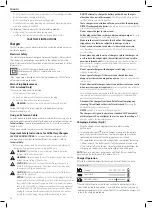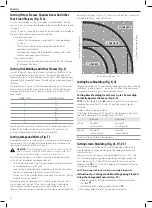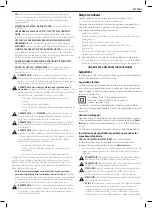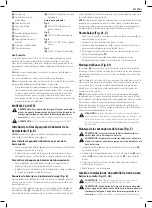
49
EnGLIsh
To lock the saw head in the down position, push the saw head down, push
the lock down pin
11
in and release the saw head. This will hold the saw
head safely down for moving the saw from place to place. To release, press
the saw head down and pull the pin out.
slide Lock Lever (Fig. k, U)
The slide lock lever
62
places the saw in a position to maximize cutting of
base moulding when cut vertically as shown in Figure U.
Right-Hand Flip Down Stop (Fig. A1, A2)
The right-hand flip down stop
35
is mounted on the sliding fence
13
and
can be rotated backward when not needed. When cutting multiple pieces
at the same width, rotate the right-hand flip down stop forward, move out
the sliding fence to the required distance from the blade (to be measured
by a ruler) and with the wood board facing against the stop make the cut.
Adjustment
Your mitre saw is fully and accurately adjusted at the factory at the time of
manufacture. If readjustment due to shipping and handling or any other
reason is required, follow the instructions below to adjust your saw. Once
made, these adjustments should remain accurate.
Mitre Scale Adjustment (Fig. I, L)
1. Unlock the mitre lock handle
21
and swing the mitre arm until the
mitre latch button
22
locks it at the 0° mitre position. Do not lock the
mitre lock handle.
2. Place a square against the saw’s fence and blade, as shown. (Do not
touch the tips of the blade teeth with the square. To do so will cause an
inaccurate measure ment.)
3. If the saw blade is not exactly perpendicular to the fence, loosen the
four screws
51
that hold the mitre scale
19
and move the mitre lock
handle and the scale left or right until the blade is perpendicular to the
fence, as measured with the square.
4. Retighten the four screws. Pay no attention to the reading of the mitre
pointer
49
at this time.
Mitre Pointer Adjustment (Fig. I)
1. Unlock the mitre lock handle
21
to move the mitre arm to the
zero position.
2. With the mitre lock handle unlocked, allow the mitre latch to snap into
place as you rotate the mitre arm to zero.
3. Observe the mitre pointer
49
and mitre scale
19
shown in Figure I.
If the pointer does not indicate exactly zero, loosen the mitre pointer
screw
50
holding the pointer in place, reposition the pointer and
tighten the screw.
Bevel Square to Table Adjustment (Fig. A1, A2, J, M)
1. To align the blade square to the table, lock the arm in the down
position with the lock down pin
11
.
2. Place a square against the blade, ensuring the square is not on top of a
tooth (Fig. M).
3. Loosen the bevel lock knob
33
and ensure the arm is firmly against the
0° bevel stop.
4. Rotate the 0° bevel adjustment screw (
59
Fig. J) with the 6 mm blade
wrench
31
as necessary so that the blade is at 0° bevel to the table.
Bevel Pointer Adjustment (Fig. J)
If the bevel pointers
53
do not indicate zero, loosen each screw
52
that
holds each bevel pointer in place and move them as necessary. Ensure the
0° bevel is correct and the bevel pointers are set before adjusting any other
bevel angle screws.
Bevel Stop 45° Right and Left Adjustment (Fig. A2, J)
To adjust the right 45° bevel stop:
1. Slide the fence
13
to the full out position before beveling the saw.
2. Loosen the bevel lock knob
33
and pull the 0° bevel stop
34
to
override the 0° bevel stop.
3. When the saw is fully to the right, if the bevel pointer
53
does not
indicate exactly 45°, turn the left 45° bevel adjustment screw
58
with
the 6 mm blade wrench
31
until the bevel pointer indicates 45°.
To adjust the left 45° bevel stop:
1. Slide the fence
13
to the full out position before beveling the saw.
2. Loosen the bevel lock knob and tilt the head to the left.
3. If the bevel pointer does not indicate exactly 45°, turn the right 45°
bevel adjustment screw until the bevel pointer reads 45°.
Adjusting the Bevel Stop to 22.5° (or 30°) (Fig. A2, J)
nOTE:
Adjust the bevel angles only after performing the 0° bevel angle and
bevel pointer adjustment. Slide the sliding fences to the full out position
before starting the 22.5° or 30° bevel adjustment.
To set the left 22.5° bevel angle, flip out the left 22.5° bevel pawl
56
.
Loosen the bevel lock knob
33
and tilt the head fully to the left. If the bevel
pointer
53
does not indicate exactly 22.5°, turn the crown adjustment
screw
54
contacting the pawl with a 10 mm wrench until the bevel pointer
reads 22.5°.
To adjust the right 22.5° bevel angle, flip out the right 22.5° bevel pawl.
Loosen the bevel lock knob and pull the 0° bevel stop
34
to override the 0°
bevel stop. When the saw is fully to the right, if the bevel pointer does not
indicate exactly 22.5°, turn the crown adjustment screw
54
contacting the
pawl with a 10 mm wrench until the bevel pointer indicates exactly 22.5°.
Fence Adjustment (Fig. A1)
The upper part of the fence can be adjusted to provide clearance, allowing
the saw to bevel to a full 49° both left and right.
1. To adjust each fence
13
, loosen the fence adjustment knob
12
and
slide the fence outward.
2. Make a dry run with the saw turned off and check for clearance.
3. Adjust the fence to be as close to the blade as practical to provide
maximum workpiece support, without interfering with arm up and
down movement.
4. Tighten the fence adjustment knob securely.
5. When the bevel operations are complete, relocate the fence.
nOTE:
The tracks of the fences can become clogged with sawdust. Use a
brush or some low pressure air to clear the guide grooves.
Guard Actuation and Visibility (Fig. Y)
The lower guard
1
on your saw has been designed to automatically
uncover the blade when the arm is brought down and to cover the blade
when the arm is raised.
The guard can be raised by hand when installing or removing saw blades
or for inspection of the saw. NEVER RAISE THE lower GUARD MANUALLY
UN LESS THE BLADE IS STOPPED.
Rail Guide Adjustment (Fig. A1)
Regularly check the rails
9
for play or clearance.
The left rail can be adjusted with the set screw
7
. To reduce clearance,
use a 4 mm hex wrench and rotate the set screw clockwise gradually while
sliding the saw head back and forth.
Mitre Lock Adjustment (Fig. A1, N)
The mitre lock rod
60
should be adjusted if the table of the saw can be
moved when the mitre lock handle is locked (down).
1. Put the mitre lock handle
21
in the unlocked (up) position.
2. Using a slotted screwdriver, tighten the mitre lock rod by turning it
clockwise as shown in Figure N. Turn the lock rod until it is snug, then
turn counterclockwise one turn.
3. Re-lock the mitre lock to a non-detented measurement on the mitre
scale – for example, 34° – and make sure the table will not rotate.
Prior to Operation (Fig. A1, A2)
• Install the appropriate saw blade. Do not use excessively worn blades.
The maximum rotation speed of the tool must not exceed that of the
saw blade. Do not use any abrasive blades.
Содержание DCS727
Страница 1: ...Final Page Size 172 x 240 mm DCS727 ...
Страница 4: ...2 Fig D Fig C Fig B Fig E Fig F 41 42 5 4 61 4 5 39 68 40 36 ...
Страница 5: ...3 Fig G Fig H4 Fig I Fig H1 Fig H2 Fig H3 1 44 1 43 31 21 22 19 51 49 50 46 43 45 31 48 47 ...
Страница 6: ...4 Fig N Fig O1 Fig L Fig M Fig K 21 21 60 62 Fig J 10 59 52 53 54 55 56 57 58 ...
Страница 7: ...5 Fig O2 Fig Q Fig S Fig P Fig T Fig R 2 1 A 1 2 ...
Страница 8: ...6 Fig X1 Fig W1 Fig W1 Fig V2 Fig V1 13 46 17 13 46 13 13 17 Fig U ...
Страница 9: ...7 Fig X2 Fig Y Fig AA Fig Z 1 63 64 15 16 66 65 67 ...
















































